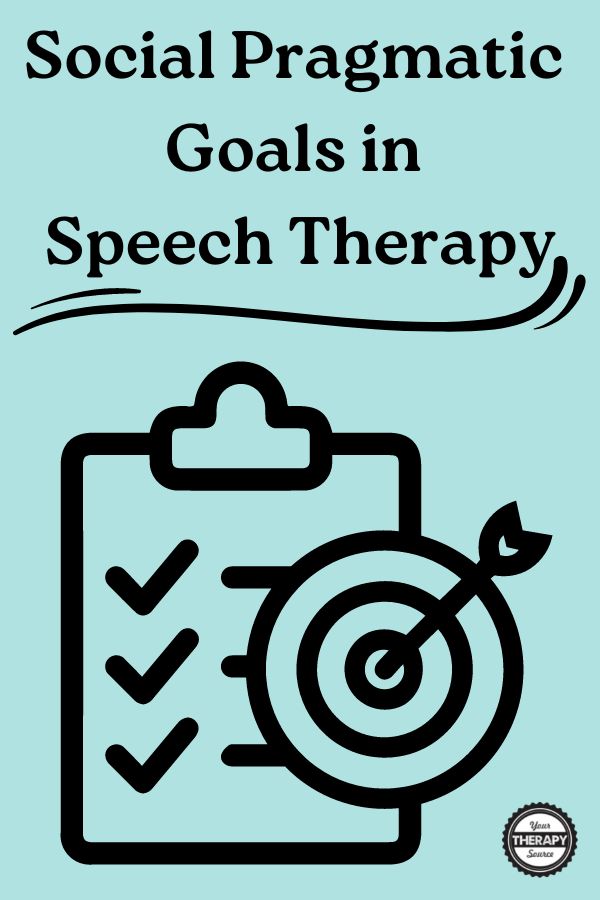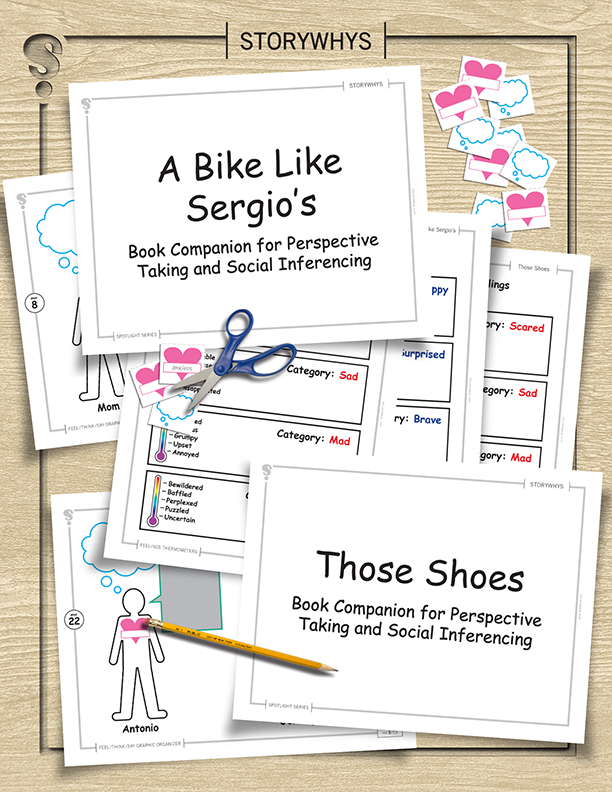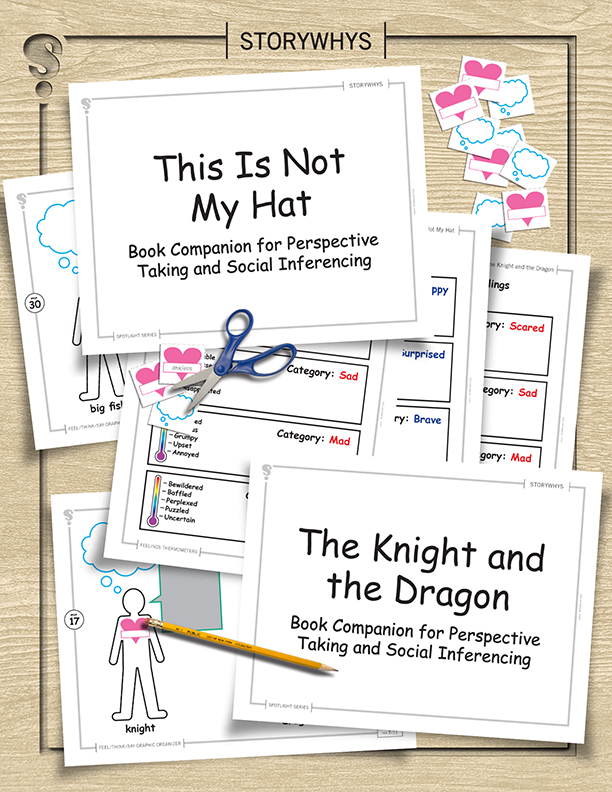Social Pragmatic Goals Speech Therapy

Are you looking to implement social pragmatic goals in speech therapy? Read on for some helpful information and ideas.
Many of the populations we work with as speech-language pathologists (SLPs), including individuals with intellectual disabilities (ID), traumatic brain injuries (TBI), attention deficit disorder (ADD/ADHD), developmental language disorder (DLD), autism spectrum disorder (ASD), and those with hearing impairments, may exhibit difficulties in their social communication skills.
According to the American Speech-Language Hearing Association, social communication has underpinnings in the areas of pragmatics (how our communication is affected by social context), social interaction skills, social cognition (our understanding of the thoughts and feelings of others, as well as social norms), and language processing (how we comprehend and formulate language).
Across settings, you’ll hear many of these terms, e.g., social skills, social language skills, social pragmatics, pragmatic skills, pragmatic language skills, etc. used interchangeably among other professionals. They are likely all referring to the same thing: social communication.

Book Companions for Perspective Taking and Emotions Vocabulary
WHAT IS A PRAGMATIC LANGUAGE GOAL?
As SLPs, we are ethically responsible to understand the social and cultural norms for the populations we work with so that we can provide culturally sensitive and meaningful assessments and treatment to our students in school settings. If a student requires support with their pragmatic language in order to be more successful in their academic setting, a pragmatic language goal should be included in their individualized education program (IEP).
A pragmatic language goal is any speech therapy goal that will support a student – in a functional way – with their social communication (or an underlying skill), in their classroom and throughout their school day.
Like all other IEP goals, pragmatic language goals should be SMART and individualized for the needs and learning profile for each specific student. See this post to learn more about writing SMART IEP goals.
WHAT IS AN EXAMPLE OF SOCIAL PRAGMATICS?
Social communication skills are embedded in nearly every facet of a child’s school day, no matter their age.
Examples include:
- A student greets his teacher in the morning, and then adjusts to a more informal tone of voice to greet his best friend.
- A preschooler sits in circle time and answers a question when it is her turn by raising her hand and waiting for her teacher to call on her.
- A high school student balances an opinion essay she is writing by acknowledging opposing points of view.
- Upon returning his classroom, a second grader observes that his classmates are reading silently so he quietly retrieves his book and returns to his desk to begin reading.
- A sixth grader infers the perspectives of different characters in the book she is reading, which allows her to understand why the characters behave the way they do.
- A preschooler shares their crayon with a classmate who is looking for one.
- A high school student works successfully on a group project by offering to be responsible for, and following through on, their portion of the research and writing.
- A fifth grader adjusts her tone of voice and rate of speech with her book buddy who is in kindergarten.
SOCIAL PRAGMATIC GOALS FOR SPEECH THERAPY PRESCHOOL
Here are some social communication goals that might be appropriate for a preschooler:
“Within one year, Anthony will correctly infer and label character feelings in simple storybooks he chooses from the library in his classroom by using simple emotions vocabulary (happy, mad, sad, scared, etc.) in response to the question, “How is (character name) feeling?” when the story is read to him, with faded verbal cues in 3 out of 4 opportunities, over 3 consecutive sessions, as measured by the speech therapist and/or classroom teacher.”
“By the end of the school year, Alexandria will demonstrate moments of shared affect by approximating gestures, words, and intonation in finger play songs during circle time with her classmates in 2 out of 3 opportunities over 5 consecutive sessions with faded visual cues, as measured by the speech therapist and/or classroom teacher.”

Emotions and Perspective Taking Book Companions
PRAGMATIC GOALS FOR SPEECH THERAPY ELEMENTARY SCHOOL
Here are some social communication goals that might be appropriate for an elementary school student:
“Within one year, Brandon will improve his perspective-taking skills by analyzing the nonverbal communication (body language, gestures, facial expressions) of story characters and making plausible inferences about both their thoughts and feelings with 90% accuracy over 5 consecutive sessions, as measured by the speech therapist.”
“By the end of the school year, Ebony will maintain a conversational topic during a role playing scenario by making related comments and asking meaningful questions, when given a subject she is interested in, with one other peer for 7 conversational turns in 7 out of 10 opportunities with faded verbal prompts, as measured by the speech therapist.”
SOCIAL PRAGMATIC GOALS FOR SPEECH THERAPY HIGH SCHOOL
Here are some social communication goals that might be appropriate for older students:
“In one year, Malcolm will improve his comprehension of figurative language by using context clues in reading passages to choose the correct meaning of 30 previously unfamiliar idioms and 30 previously unfamiliar metaphors, each from a field of 5 multiple choice answers with a minimum of 90% accuracy as measured by the speech therapist.”
“By the end of the school year, Emma will identify the appropriate context(s) (e.g., in a class discussion, at lunch with friends, etc.) for given statements with 90% accuracy as measured by the speech therapist.”
PRAGMATIC GOALS FOR SPEECH THERAPY AUTISM
Social communication difficulties across multiple contexts are one of the main diagnostic criteria for people with ASD, according to the The Diagnostic and Statistical Manual of Mental Disorders, Fifth Edition.
In recent years, as awareness and acceptance of neurodiversity has increased, there has been a shift away from potentially detrimental interventions that have employed behavioral techniques that focus on eliminating “undesirable” behaviors, regardless of the reasons they might be occurring, and promoting “appropriate behaviors”, regardless of whether they represent genuine social connection, or feel comfortable to the individual receiving the treatment.
One example of this is the behavior of establishing eye contact with communication partners. While making eye contact with someone we are interacting with can show that we are interested in what our partner is saying, making or sustaining eye contact can feel extremely uncomfortable to many people with ASD. For a student with ASD who is uncomfortable making eye contact, a more supportive pragmatic language goal might be to teach them alternative ways to let their communication partners know that they are interested.
When choosing pragmatic goals for students with autism, as with all of our students, we must generate our goals with sensitivity and with the aim to make them as meaningful as possible to our students.
Reference:
American Speech-Language-Hearing Association. (n.d.). Social communication disorder [Practice portal]. www.asha.org/Practice-Portal/Clinical-Topics/Social-Communication-Disorder/
RELATED POSTS
Problem Solving Goals Speech Therapy
List of Strengths and Weaknesses for IEPs
AUTHOR BIO
The Social Pragmatic Goals Speech Therapy article was written by Jane Clapp, MA, CCC-SLP. She has worked as a pediatric speech-language pathologist in New York City schools for over 20 years. She is the creator of StoryWhys book companions, which help SLPs provide high-quality, literature-based language therapy with elementary aged students. You can find resources, ideas, and information for busy SLPs on her blog, StoryWhys.com



